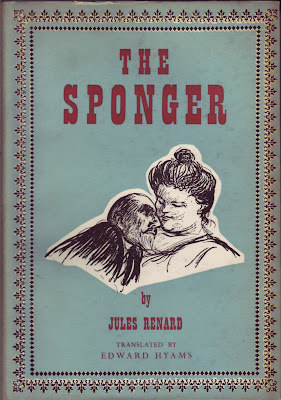
Images and excerpts from The Sponger by Jules Renard (trans. Edward Hyams, Longmans, Green and Co., 1957; in French, L'Écornifleur, 1892).
Note on copyright page: "The illustrations were drawn by Ch. Huard and engraved on wood by G.Lemoine for the original French edition."
From Edward Hyams' preface: "Some years ago L'Écornifleur received a remarkable tribute: a literary jury composed of Francois Mauriac, Jacques de Lacretelle, Andre Maurois, Francis Carco(!), Marcel Pagnol, Colette, and other distinguished persons of letters, included the book in a list of the twelve best French novels of the nineteenth century."
From the flap copy: "It is the story of Henri, an aspiring poet in the Paris of the 'eighties, who can deceive everyone as to the power and quality of his talent with the unfortunate exception of himself. He becomes a sort of domestic parasite in the household of the Vernets; M. Vernet is a self-made businessman, his wife a self-made woman of sensibility."


Excerpt:
He recharged my plate. Silently, our jaws competed. Mme Vernet repeated that she adores hard bread. M. Vernet gave her all the crusts. Mlle Marguerite added hers and, timidly, I offered mine. It became a game. I was stuffing myself with crumb, so that she should not go short of crust, ready to suffer indigestion for the pleasure of observing the soundness of her teeth. But I was beaten by Mlle Marguerite: she it was who ate most and provided the most crusts. Her nose, doing her toiling mouth's share of breathing, produced a continuous humming sound.
I could hear it, but was looking at her as if trying to see it. Every now and then she tried to laugh. Drama! She choked, mouthfuls were regurgitated, her cheeks were inflated, her lips forced open despite her efforts, and out into her unfolded napkin flew a burst of white things, resembling those flakes of filed horn which are put in glass balls full of water, to imitate snow.




A little earlier Mme Vernet's eating is described:
She has taken to affecting a taste, hitherto denied her, for plain food. Leaving wine to townsmen, she will drink nothing but cyder. Her lips crinkle at it, like the leaves of a sensitive plant. Is she smiling? Or making a face? She likes home-made bread, hard and blackish at best; knives which will not cut, glasses without stems. She would like to have insects falling into the food.

See my previous posts:
--The Journal of Jules Renard
--Jules Renard, translated by Richard Wilbur


